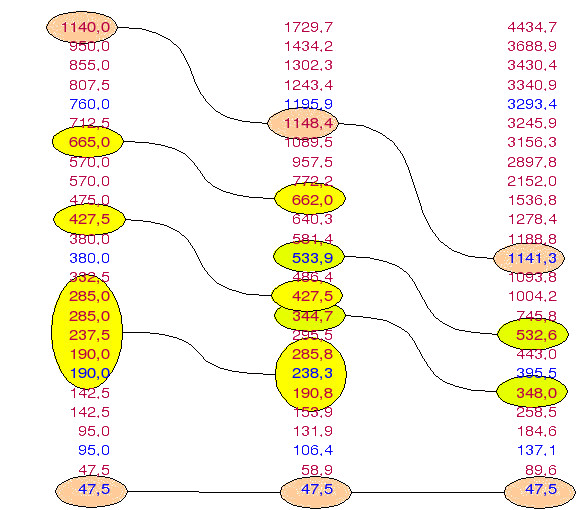Winter Leaves is an investigation into the relationships between harmony and timbre.
The basic technique is to build sounds whose spectra have a harmonic value. One of the ways to achieve this is to create sounds whose spectral components have chordal relationships.
In fact, Winter Leaves is based on 3 sounds, each made up of 5 sinusoids whose frequencies have a fixed musical interval between them. All sounds are built on the same root (47.5 Hz, about G). The other 4 components have ratios of 2 (8ve) in the first sound, of 2.24 (major 9th) in the second and 2.8856 (non-tempered interval corresponding to an increasing 11th) in the third.
The 3 basic sounds, therefore, have the following sinusoidal components:
- Ratio 2 -> 47.5, 95, 190, 380, 760 (overlapped 8ve)
- Ratio 2.24 -> 47.5, 106.4, 238.3, 533.9, 1195.9 (overlapped 9th)
- Ratio 2.8856 -> 47.5, 137.1, 395.5, 1141.3, 3293.4 (overlapped 11th+).
Of course spectra like this have both a tonal and a harmonic value. In the first spectrum the sound is a perfect consonance, in the second is a temperated dissonance and in the third with a non-tempered sound.
Each of these spectra, synthesized with 5 oscillators, is then enriched by a ring modulation between the 5 basic components taken 2 to 2. By this way we create more components whose frequencies are the sum and the difference between the basic ones. This new frequencies are used both as spectral components and as ‘notes’ on which to articulate the melodic/harmonic structure.
The following table shows the 3 sets of frequencies that can be seen both as a melodic/harmonic structure and timbral organization. In fact, Winter Leaves is totally built on them because:
- the melodic/harmonic texture is based on the 3 sets considered as scales, used in most cases alone and superimposed only in the phases of transition from one set to another (passages which happens frequently throughout the piece)
- the timbral texture uses only these frequencies as sinusoidal components of the sounds, from one set at a time (there is no sound that is a mix of frequencies coming from several sets) with overlapping at the points of passage. To obtain these sounds, 3 types of instruments have been programmed in Music360 (the CSound’s ancestor):
- additive synthesis on the 5 basic components (generates only the blue components, yellow background)
- ring modulation synthesis between one or more pairs of base frequencies (generates the red components with or without the generator pairs)
- various combinations of the above 2, up to an instrument that generates a sound containing all the frequencies of an ensemble
There are, therefore, both spectra with a normal type organization in which the lowest components are also the strongest and the amplitude decreases towards the treble, and sideband spectra in which the central components have greater amplitude.
| Ratio 2 |
Ratio 2.24 |
Ratio 2.8856 |
|||
| Freq. Base |
Freq. ± | Freq. Base |
Freq. ± | Freq. Base |
Freq. ± |
| 1140.0 | 1729.7 | 4434.7 | |||
| 950.0 | 1434.2 | 3688.9 | |||
| 855.0 | 1302.3 | 3430.4 | |||
| 807.5 | 1243.4 | 3340.9 | |||
| 760.0 | 1195.9 | 3293.4 | |||
| 712.5 | 1148.4 | 3245.9 | |||
| 665.0 | 1089.5 | 3156.3 | |||
| 570.0 | 957.5 | 2897.8 | |||
| 570.0 | 772.2 | 2152.0 | |||
| 475.0 | 662.0 | 1536.8 | |||
| 427.5 | 640.3 | 1278.4 | |||
| 380.0 | 581.4 | 1188.8 | |||
| 380.0 | 533.9 | 1141.3 | |||
| 332.5 | 486.4 | 1093.8 | |||
| 285.0 | 427.5 | 1004.2 | |||
| 285.0 | 344.7 | 745.8 | |||
| 237.5 | 295.5 | 532.6 | |||
| 190.0 | 285.8 | 443.0 | |||
| 190.0 | 238.3 | 395.5 | |||
| 142.5 | 190.8 | 348.0 | |||
| 142.5 | 153.9 | 258.5 | |||
| 95.0 | 131.9 | 184.6 | |||
| 95.0 | 106.4 | 137.1 | |||
| 47.5 | 58.9 | 89.6 | |||
| 47.5 | 47.5 | 47.5 |
Analyzing the 3 sets, it can be seen that the properties of the base frequencies are reflected in the frequencies generated by sum and difference. In particular:
- ratio 2 generates only harmonic components
- the ratio 2.24 generates both harmonic and inharmonic components
- the ratio 2.8856 generates almost exclusively inharmonic components
So it is possible to gradually move from fields of harmonic sounds to fields of partially or totally inharmonic sounds by juxtaposing and/or superimposing areas in which the musical figures are articulated on different ensembles. The following image highlights the common areas that can be used as a bridge.

Winter Leaves gain a mention at the 9th International Electroacoustic Music Awards in Bourges (1981) and was analyzed in detail in a PhD thesis in Musique et musicologie du XXème siècle at the Université de Paris IV – Sorbonne and Music Sciences at the Università degli Studi di Trento (XVI cycle) [Laura Zattra, Science and technology as sources of inspiration at the CSC of Padua and the IRCAM of Paris, 2003]. Here you can read a summary in Italian of the analysis taken from the above thesis.
Click here to listen. Duration about 8’30 “.
NB: MP3 compressed at bitrate 128. Original on vinyl [ConTempo Musical Editions INSOUND 2 – Record LP Edipan PRC S2016].
